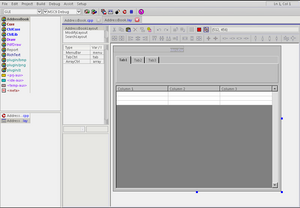Software:Ultimate++
From HandWiki
Short description: C++ RAD interface GUI framework
 TheIDE from 2010 | |
| Developer(s) | U++ team[1] |
|---|---|
| Initial release | 2004 |
| Stable release | 2023.1
/ 1 June 2023[2] |
| Preview release | 2023.1
/ May 2, 2023 |
| Written in | C++ |
| Operating system | Unix/Linux/FreeBSD (X11), Windows, Windows CE, MacOS |
| Platform | Cross-platform |
| Type | Application framework |
| License | BSD license |
| Website | ultimatepp |
U++, formally known as Ultimate++ - is a C++ RAD framework that aims to reduce the code complexity of typical desktop applications by extensively exploiting C++ features. Programs created with it can work on multiple operating systems and hardware architectures without the need to write platform-specific code.
It possesses an integrated development environment called TheIDE[3] that is designed to handle all library features.
Features
The major U++ features are:
- Includes an IDE with a layout designer.
- Uses heavily RAII and auto pointers-like mechanisms to avoid manual memory management and even to limit the use of pointers in the code [4]
- Can emulate[5] native widgets look and feel. On X11 systems, Ultimate++ supports GTK+ widgets look and feel.
- The standard distribution comes with U++ sources included, even the IDE ones.
- Uses NTL as a template system instead of STL.
- Built-in support for databases, with libraries for connecting to various database systems.
- Designed for high-performance application use cases with a low memory footprint and efficient use of system resources.
- Retains backward compatibility, allowing developers to upgrade to new versions of the framework without breaking existing code.
- Provides full support for Unicode, allowing developers to create applications that can handle different languages and character sets.
- Easy to integrate with other libraries, including third-party libraries and legacy code.
- Document editor[6] for writing documentation for people to understand the code or what you're working with.
- Code assisting[7] is built-in to it. Auto-completion and other functions work on it.
- Creating icons[8] for your application is possible without much work.
- Can work with Android NDK and SDK[9]
- Web development and other features [10]
Supports
Operating system
- Windows
- Linux
- Unix-Like OS
- macOS
Compilier
- GCC
- Clang
- Visual C++
- MinGW
Software built on U++
Example applications using U++ are:
- BEMRosetta[11] - hydrodynamic coefficients viewer and converter
- Openwind[12] - wind farm design software
- UppCAD[13] - multipurpose CAD system[14]
- WordNet Browser - browser for WordNet
See also
References
- ↑ "U++ team". http://ultimatepp.org/app$ide$About$en-us.html.
- ↑ "Release history". https://www.ultimatepp.org/www$uppweb$Roadmap$en-us.html.
- ↑ Getting started with Ultimate++ CodeProject article
- ↑ U++ Overview
- ↑ Chameleon examples
- ↑ "Topic++ :: U++". https://www.ultimatepp.org/app$ide$Topic$en-us.html.
- ↑ "Assist++ :: U++". https://www.ultimatepp.org/app$ide$Assist$en-us.html.
- ↑ "Icon Designer :: U++". https://www.ultimatepp.org/app$ide$IconDes$en-us.html.
- ↑ "Android builder :: U++". https://www.ultimatepp.org/app$ide$AndroidBuilder$en-us.html.
- ↑ "U++ Technologies :: U++". https://www.ultimatepp.org/www$uppweb$UppTechnologies$en-us.html.
- ↑ "U++ forum: Welcome to the forum". https://www.ultimatepp.org/forums/index.php?t=msg&th=10618&start=0&.
- ↑ "Building OpenWind". https://ubuntuforums.org/archive/index.php/t-1715339.html.
- ↑ "Ultimate++ Forums - UppCAD". https://www.ultimatepp.org/forums/index.php?t=msg&th=10500&start=0&.
- ↑ "UppCAD". https://uppcad.com/home.html.
External links
 |

